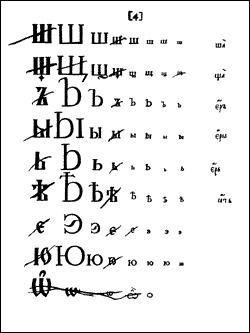 | ||
E (Э э; italics: Э э; also known as backwards e, from Russian э оборо́тное, e oborótnoye, [ˈɛ ɐbɐˈrotnəjə]) is a letter found in two Slavic languages: Russian and Belarusian. It represents the [e] and [ɛ]. In other Slavic languages that use the Cyrillic script, the sounds are represented by Ye (Е е), which represents in Russian and Belarusian [je] in initial and postvocalic position or [e] and palatalizes the preceding consonant.
Contents
- Origin
- In modern Russian
- In modern Belarusian
- In other languages
- Related letters and other similar characters
- References
In Cyrillic Moldovan, which was used in the Moldovan SSR during the Soviet Union and is still used in Transnistria, the letter corresponds to ă in the Latin Romanian alphabet. It is also used in the Cyrillic alphabets used by Mongolian and many Uralic, Caucasian languages and Turkic languages of the former Soviet Union.
Origin
The letter ⟨э⟩ originated in the thirteenth century as a variant of ⟨є⟩, at first, according to Djordjić in superscripted line-final position, but by the end of the century elsewhere as well. In the following centuries it continued to appear sporadically as an uncommon variant of ⟨є⟩, but not later than in the fifteenth century amongst the Eastern Slavs it began to be used to indicate initial (un-iotated) [e]. According to Yefim Karskiy, "Western Russian ustav knows ⟨э⟩, e.g. in Miscellany of the 15th c. from the Public Library (manuscr. #391) (экъсеквїє etc.), chronicles of 15th-16th cc., Miscellany of Poznań (16th c.), Statut of 1588... It is difficult to say whether it has been developed here independently or it came from South Slavic manuscripts, where ⟨э⟩ occurs as early as in 13-14th cc." Although the revision of Meletius Smotrytsky’s grammar published in Moscow in 1648 does not include ⟨э⟩ in its alphabet, it does consistently write Этѷмолѻ́гїа (Etymologia), in contrast to Єтѷмоло́ґїѧ in the first edition of 1619. It was by no means confined to this function in the period, however, as the prevalent spellings реэстръ, маэоръ (beside маиоръ, маіоръ) demonstrate.
In modern Russian
In the specimens of the civil script presented to Peter I in 1708, forms of ⟨э⟩ were included among forms of ⟨є⟩, but the latter was deleted by Peter. The former was used in some early 18th-century Russian texts, but some authorities of the period considered it superfluous, like Mikhail Lomonosov, on the grounds that "the letter Е, having several different pronunciations, could serve in the pronoun етотъ and the interjection ей" letters solely for use in loanwords. However, the inclusion of ⟨Э⟩ in its modern function, in the Russian Academy's Dictionary of 1789–94, marks the point from which it can be considered as an established part of the Russian orthographical standard.
There was still some objections to the letter even as late as 1817, when M. T. Kačenovskij was questioning whether "yet another hard э" was necessary when the language already had "a soft ѣ and a hard е".
In contemporary Russian, ⟨э⟩ is used to represent [e], [ɛ] in initial position (электричество 'electricity') and postvocalic position (дуэль 'duel'). Among such words are only a few native Russian roots: эт- (это 'this is', этот/эта/это 'this (m./f./n.)', эти 'these', поэтому 'thus' etc.), эк- (экий 'what a'), эдак-/этак- (эдак/этак 'that way', эдакий/этакий 'sort of') and few interjections like эй 'hey', э 'uh, oh', э-э-э 'uh'.
Even though Russian contains a significant number of loanwords in which [e] occurs after a hard (unpalatalised) consonant, it is still the practice to use the letter ⟨е⟩ for [e], [ɛ]: теннис, сепсис. There are few traditional exceptions to that practice among common noun loanwords:
In proper nouns, however, ⟨э⟩ may occur after consonants: Улан-Удэ 'Ulan-Ude' and Блэр 'Blair'. However, many such loanwords are spelled with ⟨е⟩: Блерио 'Blériot' (a French aviator). That is the case especially for names that entered the language centuries lik: Берлин, 'Berlin'. The use of ⟨э⟩ is much more frequent for names from non-European languages: Мао Цзэдун 'Mao Zedong'.
The letter ⟨э⟩ is also used in Russian to render initial [œ] in foreign words: thus Eure (the river in France) is written Эр. After consonants this is transcribed as ⟨ё⟩. In the 19th century, some writers used ⟨ӭ⟩ for that sound in both positions, but that was never accepted as standard orthography. (The letter ⟨ӭ⟩ was re-invented in the 20th century for Kildin Sami.) It is also used to represent a stressed [æ] in languages such as English, which can cause a problem of conflating [æ] with English [ɛ] (for example, "Addison" and "Edison" would be spelled the same). However, in other positions, Russian also uses ⟨а⟩ for [æ] and ⟨е⟩ for [ɛ].
In modern Belarusian
Unlike Russian, Belarusian has many native words in which it occurs after a hard consonant. Moreover, its orthography was standardized later than that of Russian (which reached its present form at the beginning of the 20th century), on the basis of the spoken language rather than historical tradition. Consequently, ⟨э⟩ and ⟨е⟩ are written in accordance with pronunciation: ⟨э⟩ for initial [e] and after hard consonants, ⟨е⟩ for initial and postvocalic [je] and after soft consonants. That also means that ⟨э⟩ is much more frequent in Belarusian than in Russian.
In other languages
In Tuvan the Cyrillic letter can be written as a double vowel.
